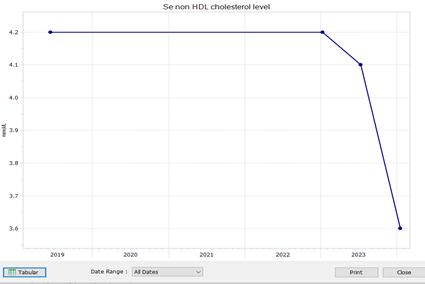Lipid optimisation in North Cumbria
7th February 2024
At HI NENC we have developed tried and tested resources and ways of working to support primary care to achieve their QOF lipid targets.
To share learning from across the region, we spoke to Nicola Sumbler, Lead PCN Clinical Pharmacist at Keswick and Solway PCN, and Jennifer Nellis, NECS Medicine Optimisation Pharmacist within Cockermouth & Maryport PCN , who share the learnings of lipid optimisation work within North Cumbria.
Nicola shares practicalities and the ‘how to’ of lipid optimisation, and Jennifer shares some insights of putting this into practice with some patient stories.
Lipid optimisation ‘how to’ – top tips from Nicola
Lipid optimisation has certainly been a hot topic over the last 12 months, solidified by its inclusion in QOF. As lead of Keswick and Solway PCN’s pharmacy team, this was just the oomph! we needed to get the PCN and GP practices on board with some lipid focussed work.
Colleagues from Health Innovation North East North Cumbria (HI NENC) provided support tools and resources to get the ball rolling. Coupled with clear guidelines and initial training, the team (no matter how experienced) felt confident to get started. My practice has been lucky enough to have pharmacy technician involvement (perfect for arranging blood tests, appointments and engaging in initial patient reviews) but adopting a standardised process across the PCN has proven unrealistic due to limited technician resource. We have recognised, however, that agreeing who does what in each practice is fundamental to success.
To ensure lipid optimisation remains a priority, inclusion of a lipid profile in routine monitoring is essential. Approaching patient discussions with mutual understanding, exploring treatment options and encouraging any concerns to be expressed can certainly have improved compliance. Clinical teams now review lipid blood tests differently and understand current recommendations, with the focus on non-HDL, not total cholesterol (TC). The patient who has been told for years that their cholesterol is fine may now be told it isn’t! Training sessions provided by HI NENC, at PCN and practice level, have helped provide a consistent message through increased awareness of QOF targets, current NEELI guidelines and the lipid lowering therapies available.
We have also found an increase in genetic and lipid clinic referrals, aided by improved communication with secondary care teams.
Supporting patients – top tips from Jennifer
Choosing to do my IP course in lipid optimisation came about by chance but now I would describe it as serendipity. At the time my “talents” lay in opiate and benzodiazepine reductions. After a mentally challenging consultation with a patient taking high dose opiates, I said to my GP supervisor that they must be the hardest conversations to which she replied, “why don’t you try speaking to my statin hesitant and intolerant patients?” So I did! Lipid consultations are exciting and rewarding for both me and the patient. Even when my patient doesn’t take medication, I try to take the positive from the situation ensuring I cover the risks and benefits, lifestyle interventions and plant some seeds – making every contact count!
The unexpected learning from my IP work was the huge amount of high quality evidence for statins; Cochrane Reviews, Systemic Reviews … and yet they have this stigma – which I am determined to correct with patients and colleagues. Statins get the blame for everything from sore eyes to sore toes! I enjoyed reading the paper about the legacy benefit of statins where the 20 year follow up of WOSCOPS (West of Scotland Coronary Prevention Study) demonstrated that there is a risk reduction from 5 years of pravastatin therapy that persisted over a 20 year period – I mean what’s not to like about a drug that keeps on working when you stop it?
My favourite patient was a 68-year-old secondary prevention patient who was not taking any lipid lowering therapy. He came in to discuss his non-HDL-C as it was raised, however within the last year it had dropped from 4.2mmol/L down to 3.6mmol/L and I asked him what he had done in that year. He told me he had stopped smoking in April 2023! I had to recheck his record and sure enough he wasn’t taking any medication and he said his diet was slightly worse. His graph (below) demonstrates succinctly how important it is for us to coach our patients with lifestyle interventions.
Working with HI NENC has been brilliant. They have facilitated meetings, learning sessions and networking opportunities. It’s been great to know there are others out there also trying their hardest to improve the quality of our patients lives in North Cumbria.
Supporting resources
Resources for primary care – including the pharmacy technician process map and how to guide
Thank you to Nicola and Jennifer for sharing her insightful learnings and advice about lipid optimisation.
If you’d like more support or would like to find out about the training offered by Health Innovation North East and North Cumbria, please get in touch with Nikki Holdsworth

